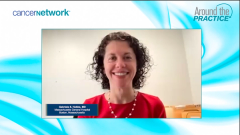
Selecting Transplantation Versus Systemic Therapy in Myelofibrosis
Focused discussion on the factors that help to select patients for stem cell transplantation over systemic therapy in the setting of myelofibrosis.
Episodes in this series

Transcript:
John O. Mascarenhas, MD: In line with this discussion on the role of transplant, Andrew, if you have someone optimized on ruxolitinib with great spleen symptom control of 68, a good performance status, and a fully matched sibling donor option, when should that patient move into the transplant side of things? When do you pull the trigger on such a patient?
Andrew T. Kuykendall, MD: It’s tough. With these patients you get concerned that you could be that frog in boiling water, where the heat is slowly turned up. You don’t want to wait too long if the patient is in too risky of a situation. With as many clinical trials as we have, and with patients feeling as well as they do, it’s hard to convince them that that’s the time to move to transplant. If you see 3 additional high-risk mutations, even if the patient is feeling well, you’re going to say, “We should probably line things up for a transplant if that’s ultimately where you want to be.” At the same time, I’ve had patients come to me and say, “I feel great. I don’t want to go in that direction now. I understand the risks, but that’s not what I want to do.” Age 68 is a good example because you get patients who feel wildly different about their goals. [We need to] understand and go through that discussion with them, making sure they understand. You could delay transplant, but we might be put in a situation where it’s not feasible when the time comes and you’re ready for it.
At the same time, if we move forward now, I can’t tell you didn’t have 4 good years on the table of being on ruxolitinib and having good disease control. It’s an ongoing discussion. I don’t know if there’s a right answer. Anyone who’s an intermediate- to high-risk patient and otherwise fit, we send them to see the transplanters right off the bat and make sure they get that full discussion. That’s often a challenging discussion. Once they come back, we circle back and talk about what our treatment would be with and without transplant. We put it in their hands and say, “We’re happy to do whatever makes the most sense for you.”
John O. Mascarenhas, MD: You contributed to the RR6 [response to ruxolitinib after 6 months] model. Do you use that in clinical practice to make the decision about pushing transplant earlier?
Andrew T. Kuykendall, MD: It can be used for a couple of reasons. To give some background on the RR6 model, this is an attempt to understand prognostic factors of patients who are being treated with ruxolitinib—to understand which patients are going to do well in the long term and which patients aren’t. The factors that came up were not surprising by any means. Patients who were on ruxolitinib were requiring transfusions, weren’t able to get optimized doses, and didn’t have robust spleen responses. Those are the patients who tend to live shorter on ruxolitinib. Having been on ruxolitinib, maybe those patients met those thresholds—patients who could be on a full dose, patients who weren’t requiring transfusions, and patients who had good spleen responses. Whether that’s specific to ruxolitinib or identifies patients with problematic disease, it can be helpful now that it’s out there, published, and validated.
If a patient is feeling OK but having to decrease the dose of ruxolitinib they can be on, because their spleen volume is improved but not substantially, and they’re still getting transfusions, there are a few things you might say. “You’re having a good response, but there’s clearly objective disease features present, which would predict that this isn’t going to last forever.” Alternatively, if you have someone who has some high-risk mutations but they’re on 20 mg of ruxolitinib twice a day, and they had a complete resolution of their splenomegaly and aren’t requiring transfusions, we might say, “We can monitor this for a bit because I don’t see any high-risk features, and perhaps play this out until some concerning cytopenias or something like that emerge.” We can revisit the transplant idea at that time.
John O. Mascarenhas, MD: There’s been a lot of literature—some of which you’ve personally contributed to—demonstrating that patients who fail ruxolitinib and discontinue ruxolitinib do poorly. That means survival, depending on the study, could range from 12 to 15 months. That makes an unmet need in salvaging patients after the first-line JAK inhibitor failure. Of course, we have other available JAK inhibitors. The NCCN [National Comprehensive Cancer Network] endorses the use of fedratinib or pacritinib, and we’ll likely have momelotinib in 2023.
But there have been interesting analyses in the second-line setting comparing patients who would move on to get transplant. These are always biased analyses because of the types of patients who would go on to get transplant vs patients who would remain on best available therapy—nontransplant options, like a second-line JAK inhibitor. Although these studies are probably small and incomplete, and greater follow-up is needed, eventually, there’s a separation in survival curves in favor of patients who receive transplant in terms of overall survival, transformation or leukemia-free survival, and general outcomes. It depends on a lot of factors, and it becomes a personal decision. But if it’s never introduced, then it’s never discussed or considered.
That’s 1 of the biggest problems in the community: the patient is never introduced to the concept of transplant, or referred appropriately early on to gauge whether their interest is in a transplant because there’s a lot involved with it. Some patients may make the decision up front that they’re never going to do that. Others would capitalize or take advantage of that, particularly if they have an available donor option like a sibling or a haploidentical adult child. The message is to consider transplant refer early, anddon’t be too complacent on ruxolitinib because of the features you’re pointing out and the potential for disease progression. Keep your eyes wide open, and be aware of what your patient’s expectations are because you want to make sure that your treatment approach is aligned with those.
Transcript edited for clarity.
Newsletter
Stay up to date on recent advances in the multidisciplinary approach to cancer.






















































































